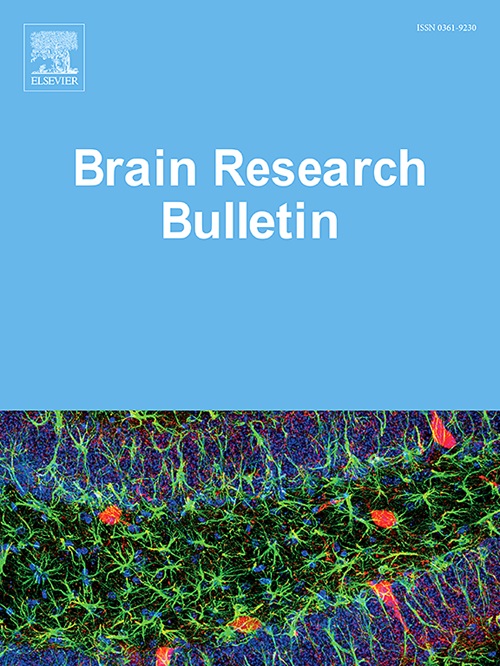电针联合葫芦巴碱通过PI3K/AKT/mTOR信号通路抑制自噬,抑制脑缺血再灌注后的焦亡。
IF 3.5
3区 医学
Q2 NEUROSCIENCES
引用次数: 0
摘要
背景:电针(EA)和葫芦巴碱(TG)已被报道对减轻脑缺血/再灌注损伤(CIRI)有益。然而,EA和TG在CIRI中的协同作用及其潜在机制尚未得到证实。方法:采用大鼠大脑中动脉闭塞(MCAO)手术和再灌注(MCAO/R)建立大鼠CIRI模型。神经功能缺损评分采用加西亚量表。采用TTC染色法测定大鼠脑梗死。HE染色观察脑组织形态。采用IF法和western blot检测各蛋白的表达。结果:EA或TG治疗能有效改善CIRI大鼠神经功能障碍,减轻脑梗死,减轻脑组织神经元损伤。此外,EA或TG处理可抑制CIRI大鼠的自噬和焦亡。更重要的是,EA和TG干预在改善CIRI大鼠神经元损伤、抑制自噬和焦亡方面具有协同作用,而自噬诱导剂Rapa在MCAO/ r诱导的大鼠中增强了这些作用。此外。Rapa联合tg介导的CIRI大鼠神经元损伤改善、自噬和焦亡抑制逆转EA。值得注意的是,PI3K/AKT/mTOR通路在CIRI大鼠中失活,EA联合TG增强了PI3K/AKT/mTOR通路的激活。LY294002是PI3K/AKT/mTOR通路抑制剂,刺激CIRI大鼠自噬和焦亡,逆转EA联合tg介导的自噬和焦亡抑制。结论:EA联合TG抑制了CIRI大鼠的焦亡,其作用机制是通过激活PI3K/AKT/mTOR信号通路来抑制自噬。本文章由计算机程序翻译,如有差异,请以英文原文为准。
Electroacupuncture combined with trigonelline inhibits pyroptosis in cerebral ischemia-reperfusion by suppressing autophagy via the PI3K/AKT/mTOR signaling pathway
Background
Electroacupuncture (EA) and trigonelline (TG) have been reported to be beneficial in alleviating cerebral ischemia/reperfusion injury (CIRI). However, the synergistic effects of EA and TG in CIRI and the underlying mechanism have not been demonstrated.
Methods
Rats were subjected to middle cerebral artery occlusion (MCAO) surgery and reperfusion (MCAO/R) to establish a CIRI model. Neurological deficit score was evaluated using Garcia’s scale. Cerebral infarction in rats was determined using TTC staining. Brain tissue morphology was assessed by HE staining. The expression of various proteins was measured using IF assay and western blot.
Results
EA or TG treatment could effectively ameliorate neurological disorders, attenuate cerebral infarction and reduce neuronal damage in brain tissue in CIRI rats. In addition, EA or TG treatment suppressed autophagy and pyroptosis in CIRI rats. More importantly, synergistic effects of EA and TG intervention in CIRI rats were observed in ameliorating neuronal damage and suppressing autophagy and pyroptosis, while Rapa, an inducer of autophagy, strengthened these effects in MCAO/R-induced rats. Furthermore. Rapa reversed EA in combination with TG-mediated improvement of neuronal damage and suppression of autophagy and pyroptosis in CIRI rats. Notably, the PI3K/AKT/mTOR pathway was inactivated in CIRI rats and EA combined with TG enhanced the activation of the PI3K/AKT/mTOR pathway. LY294002, an inhibitor of the PI3K/AKT/mTOR pathway, stimulated autophagy and pyroptosis in CIRI rats and reversed EA combined with TG-mediated suppression of autophagy and pyroptosis.
Conclusion
EA combined with TG suppressed pyroptosis, which was dependent on inhibition of autophagy in CIRI rats through activation of the PI3K/AKT/mTOR signaling pathway.
求助全文
通过发布文献求助,成功后即可免费获取论文全文。
去求助
来源期刊

Brain Research Bulletin
医学-神经科学
CiteScore
6.90
自引率
2.60%
发文量
253
审稿时长
67 days
期刊介绍:
The Brain Research Bulletin (BRB) aims to publish novel work that advances our knowledge of molecular and cellular mechanisms that underlie neural network properties associated with behavior, cognition and other brain functions during neurodevelopment and in the adult. Although clinical research is out of the Journal''s scope, the BRB also aims to publish translation research that provides insight into biological mechanisms and processes associated with neurodegeneration mechanisms, neurological diseases and neuropsychiatric disorders. The Journal is especially interested in research using novel methodologies, such as optogenetics, multielectrode array recordings and life imaging in wild-type and genetically-modified animal models, with the goal to advance our understanding of how neurons, glia and networks function in vivo.
 求助内容:
求助内容: 应助结果提醒方式:
应助结果提醒方式:


